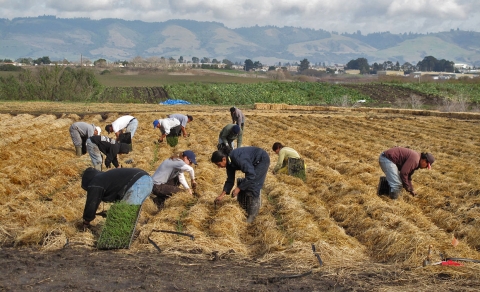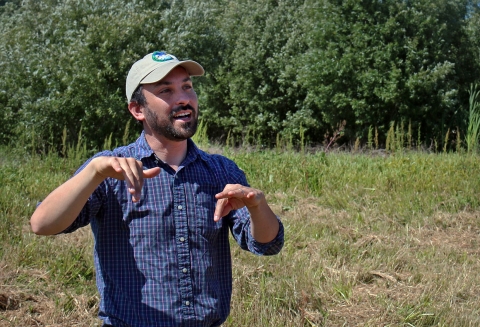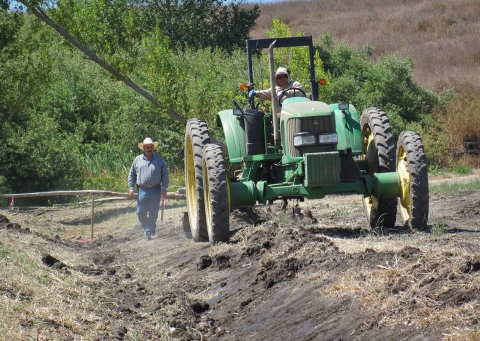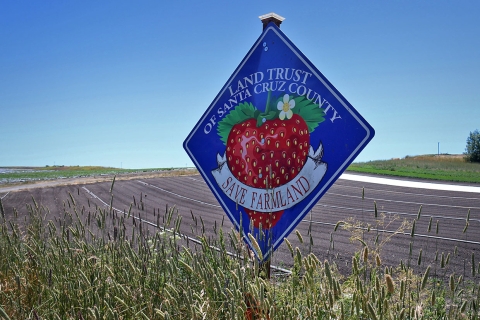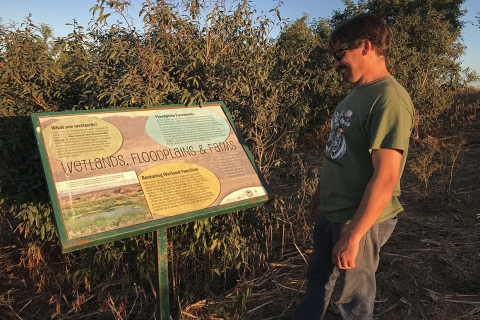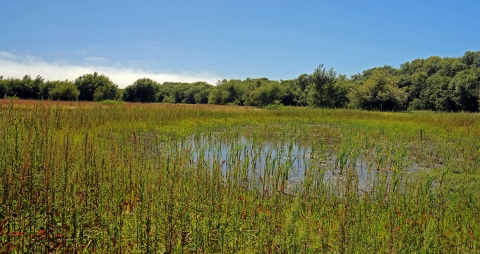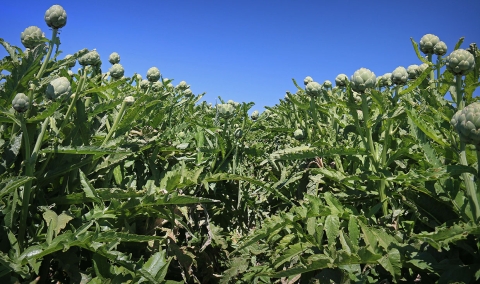By Robyn Gerstenslager
Less than a minute’s drive from the outskirts of Watsonville, California, is a hidden gem: a small coastal farming community alive with flora and fauna known as Watsonville Slough Farm. It's 500-acres lies in the heart of one of California’s largest coastal wetlands.
Through thoughtful and strategic land management on the property the wetlands, and the wildlife, are thriving alongside fields of organic artichokes taller than the average human, lettuce, broccoli, other row crops and strawberries ripe for the picking. Yet the habitat did not always look that way.
Beginning in 2008, the Land Trust of Santa Cruz County purchased 441 acres that would eventually be Watsonville Slough Farm. Funding for the purchase came from a variety of sources including the California State Coastal Conservancy, the California Wildlife Conservation Board and The Nature Conservancy. In 2010 and 2011 two additional pieces of property were purchased with support and funding from the U.S. Fish and Wildlife Service’s Coastal Program and National Coastal Wetland Conservation Grant Program.
The Coastal Program is partnership-based and works with private and public landowners to restore coastal habitat for federally threatened or endangered species. In the case of Watsonville Slough Farm, the coastal program’s first interest involved enhancing and protecting the only pond within the slough system known to support breeding California red-legged frogs.
Listed as threatened under the Endangered Species Act in 1996, California red-legged frogs are the largest native frog in the western United States. Habitat lost to land development has reduced their numbers by 70 percent.
“Over the last several years the Coastal Program has been able to provide assistance on many habitat improvement projects in the Watsonville area,” said Shawn Milar, Coastal Program Coordinator for the Service along California’s central coast. “The Watsonville Slough Farm’s restoration projects are unique in that many of them link together, creating a much larger footprint for habitat connectivity transitioning from floodplain to riparian riparian
Definition of riparian habitat or riparian areas.
Learn more about riparian [zones] and then to coastal prairie habitat all within a few hundred yards.
“Beyond the ultimate goal of improving habitat for wildlife, the Coastal Program wants to provide value to any project we are working on.”
For Watsonville Slough Farm that meant lending technical expertise in planning, implementation, monitoring and management, and in many cases providing funding for specific projects on the farm.
Historically, the area surrounding the farm was part of the floodplain of the Pajaro River, which flows east to west just south of Watsonville before it empties into the Monterey Bay. In the late 1800s, the land was drained and maintained by channel dredging primarily to support agricultural use. By the mid-1980s, maintenance operations of the land slowed, and it steadily returned to its former, marshy state.
“The parcels that make up the property have been a hotspot in the tug-of-war between biodiversity conservation and development in Santa Cruz County since the 1970s. And every few years there would be a new proposal for widespread and large scale development of that land,” said Bryan Largay, conservation director for the Land Trust of Santa Cruz County.
PARTNERS FOR LAND CONSERVATION AND CULTIVATION
In 2010, the Land Trust hired the Resource Conservation District of Santa Cruz County to help develop a long-term management plan for the properties. The plan’s vision: “Protect and restore the Watsonville Slough coastal wetland ecosystem, demonstrate economically and environmentally sustainable agricultural practices, and provide opportunities for appropriate research, public access and education.”
“Planning and implementation for recovery projects are always a village effort, and we wouldn’t be able to do it without all our partners,” said Kelli Camara, technical program director for the district. “It was a really wide group of individuals and agencies that came together to develop the conservation plans for the property.”
The growers, who already knew the lay of the land, were another vital partner in the development and execution of the management plan, and Camara said working with the growers allowed for insight not typically available during restoration of land previously used for farming or other activities.
“Most of the time you don’t have the opportunity to discuss what resources or opportunities are there with the people who are farming the land [now] and who may have been farming the land for decades,” she explained. “So it was a really unique opportunity to hear about resource issues or constraints that we wouldn’t have known otherwise.”
The collaboration between the conservationists and the growers did not stop with the development of the management plan, explained Jonathan Pilch, executive director of Watsonville Wetlands Watch, which manages the restoration work on the farm and the integration between the restored habitat and agricultural fields.
“We’ve worked really closely [with the growers] on both the planning side, in terms of identifying areas where we could strategically retire and improve native, natural habitat,” he said. “And then also on the implementation side, so using on-farm technologies as best as we can to do the habitat restoration work.”
However, that does not mean the restoration team suddenly became experts in backhoe operation.
The growers on the property share their time and farm equipment for projects like native grassland restoration, grass waterways construction, soil settlement area regrading and building alternative breeding ponds for California red-legged frogs.
“I think we recognize that there are areas in which our goals may not be completely the same,” said Pilch. “We’ve stayed in very close communication in order to move projects forward, trying to alleviate any concerns on both sides and work together in those areas in which we have the same goals: soil erosion, soil protection and water quality management.”
ONGOING RESTORATION
The restoration work on the farm is an ongoing process, with projects in completion and monitoring, and others are just getting started.
On a small portion of land, just 45 acres, Pilch and Camara are working now to restore native grassland, wet meadow and California red-legged frog habitat on farmland that was once leveled and has been out of production for years.
Currently, the team is reseeding the area with native seeds, much of which was locally collected. If all goes well, the area will eventually be covered with 30 to 40 percent or more native grassland and meadows, similar to other restored grassland areas on the farm.
The restoration work here also includes creation of ponds through topography development, to create breeding habitat for California red-legged frogs and variety in vegetation communities; supporting different wildlife species.
“It’s such a need within the community; the red-legged frog population within the Watsonville Slough is so limited, so any opportunity that we have to create breeding or upland habitat for their survival is critical,” said Camara.
She added that designing restoration that accounts for multiple species allows for future adaptive management in response to changes in climate and other influencers outside of their control.
“Since the creation of alternative breeding ponds and native grassland restoration, the red-legged frogs have expanded their breeding and wintering locations when conditions were ideal,” said Pilch. The work is also benefiting wetland and grassland-dependent species like burrowing owls, American bittern, grasshopper sparrows, horned larks, northern harriers and white-tailed kites. “The sloughs have become a part of the fabric of the city and gives community residents a sense of pride,” said Largay.
The town of Watsonville is very much a farming town, and having agriculture be sustainable is a source of great pride, too. Having very productive, job-creating farmland close to sensitive habitat is something that the region prides itself on.”
THE PARTNERSHIP
Watsonville Wetlands Watch is dedicated to the protection, restoration and fostering of appreciation of the wetlands of the Pajaro Valley, especially involving members of the Watsonville community and the students of the Pajaro Valley Unified School District.
The Resource Conservation District of Santa Cruz County facilitates stewardship projects to address water quality, biodiversity, ecosystem health, and water quantity on private and public lands through technical assistance, outreach, education and project implementation.
The Land Trust of Santa Cruz County protects, cares for and connects people to the extraordinary lands that make this area special.
The U.S. Fish and Wildlife Service in Ventura works to conserve and protect threatened and endangered fish, wildlife and plants across the central and Southern California coast, collaborating with communities and conservation partners to build a future that supports both people and our unique and diverse natural resources.
Additional partners crucial to the development and funding of the Watsonville Slough Farm land purchase, management plan development and implementation include: Alnus Ecological, Kittleson Environmental Consulting, U.S. Department of Agriculture Natural Resources Conservation Service, City of Watsonville, Pajaro Valley Water Management Agency, County of Santa Cruz, Central Coast Wetlands Group, California Coastal Conservancy, Live Earth Farms, California Department of Fish and Wildlife and the California Coastal Commission.


